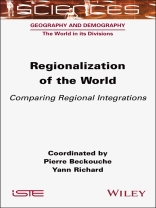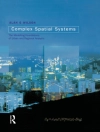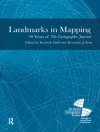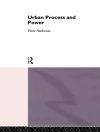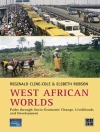On the world map, macro-regions or global regions have gradually emerged, with varying degrees of success and following different trajectories. The authors of this book attempt to determine whether, within the context of globalization, these macro-regions have become an additional level in the spatial deployment of numerous actors, and whether they have come to stand between the national and global levels.
This question has arisen because the increasing scales of trade, environmental problems, migration routes, energy distribution, the construction of major infrastructures etc. transcend national boundaries and are leading states to implement macro-regional cooperation.
The authors ask whether these large regional groupings are becoming genuine territories and are the fruit of in-depth regional integration – economic, institutional, legal, normative, political, cultural and in terms of identity. If so, these global regions would therefore become referents that make sense and take root in social representations.
Зміст
Introduction xiii
Pierre BECKOUCHE and Yann RICHARD
Chapter 1 From Regional Geography to the Geography of Regionalization 1
Pierre BECKOUCHE and Yann RICHARD
1.1 Introduction 1
1.2 19th and 20th centuries: the hesitant paths of regionalization between intra-state regions and continents 2
1.2.1 The legacy of the 18th century 2
1.2.2 Vidal and the vidalians: lifestyles, cities and circulation 2
1.3 20th century: an early but timid emergence of the world 4
1.3.1 The world as a chessboard 4
1.3.2 The inter-war period: decline of Europe, the European region, Triad 5
1.3.3 After World War II: global regions at last? 6
1.3.4 The 1980s: the world as a system 8
1.4 The turn of the 20th/21st century: relations between geographers and other disciplines are almost one way 8
1.4.1 Economics reformulates the regional equation 9
1.4.2 Trendy regionalism and multidisciplinary necessity 9
1.4.3 Contributions and aporias of the civilizational paradigm 11
1.5 References 12
Chapter 2 The Regionalization of Migration 17
Camille SCHMOLL
2.1 Introduction 17
2.2 Regionalization: main characteristics 18
2.2.1 A global trend… 18
2.2.2 …particularly strong in Europe and Sub-Saharan Africa 19
2.2.3 Contrasting developments 20
2.2.4 The share of forced migration 21
2.3 The region: a relational space, crossed by intense circulation 22
2.3.1 Naming and describing the regionalization of migration From the field to the migration system 22
2.3.2 The region ‘from below’: a circulatory territory 23
2.4 The political dimension: a crucial aspect for understanding the structuring of migrant regions 24
2.4.1 From the migration system to the migration regime, a strong political connotation 24
2.4.2 The double European migration regime 25
2.5 Conclusion: the power of proximity 25
2.6 References 26
Chapter 3 Energy Supply: Comparison of Regional Experiences 29
Angélique PALLE
3.1 Introduction 29
3.2 Francophone approaches and determining factors of regional energy integration 30
3.2.1 Approaches to francophone geography 30
3.2.2 The determining factors of regional energy integration, a process combining several layers 31
3.3 Regional energy integration models and the challenge of ecological transition 33
3.3.1 Comparison of international energy integration dynamics and typology 33
3.3.2 Is energy integration a response to the ecological transition? 36
3.4 Conclusion 37
3.5 References 38
Chapter 4 Transport Systems and Regional Integration 43
Antoine BEYER
4.1 Introduction 43
4.2 Transport and circulation: key variables in the partition models of the world into large civilizational groups 44
4.2.1 A global trend… 44
4.3 Globalized transport and hierarchical rearrangement of regional units 46
4.4 Continental transport corridors, at the heart of regional integration projects 52
4.5 The difficulty of measuring the knock-on effects of transport corridors on regional economies 55
4.6 TEN-T: political leverage for European integration 56
4.7 Towards a regionalization of international transport law? 58
4.8 Conclusion: the multidimensional construction of regional integrations through the lens of transport systems 62
4.9 References 63
Chapter 5 The Regionalization-Globalization Pair: A Reading of the Evolution of World Trade 67
Gilles VAN HAMME
5.1 Introduction 67
5.2 A methodology for analyzing regional and global dynamics 69
5.3 The main lessons learned 71
5.3.1 A regional organization of exchanges 71
5.3.2 The deglobalization of the 2010s? 73
5.3.3 What are the driving forces of these refocusing processes? 76
5.4 Towards a reinterpretation of the regionalization-globalization dynamics 77
5.4.1 From the migration regime, a strong political connotation 77
5.5 Conclusion: a look at the production of francophone geography on these issues 78
5.6 Appendix 79
5.7 References 80
Chapter 6 Stock Market Activity and the Regionalization Process 83
Maude SAINTEVILLE
6.1 Introduction 83
6.2 Regionalization in the practices of stock exchange activities: the case of cross-border listings 84
6.2.1 Observing the regionalization of cross-border listings in the context of stock exchange activities 84
6.2.2 Explaining regionalization through relational preferences 86
6.2.3 Regionalization in the face of the 2007-2008 financial crisis 86
6.3 Regionalization in the organization of the stock exchange activity: the construction of stock exchange groups 87
6.3.1 The choice of regionalization for the organization of stock exchange groups? 87
6.3.2 Regionalization favored by regional integration: the case of stock market activity within the European Union 93
6.4 What role for regionalization in the evolution of stock market activity? 94
6.5 Conclusion: the power of proximity 96
6.6 References 97
Chapter 7 The Runet, a Region of Cyberspace? 99
Kevin LIMONIER
7.1 Introduction 99
7.2 From the cultural to the political Runet: appropriation of the ‘upper layers’ of cyberspace 101
7.3 Control and dependencies on the lower layers of cyberspace 105
7.4 Conclusion 108
7.5 References 109
Chapter 8 Security Regions: A Heterogeneous World Between Conflicts and Cooperation 111
Emmanuel CHAUVIN
8.1 Introduction 111
8.2 Regional security cooperation: globalization and diversification 112
8.2.1 Security, the basis of regional construction 112
8.2.2 Security for the regions: from defense to human security 114
8.2.3 Regional security architectures: a variety of styles 117
8.3 Realities and myths of the regionalization of insecurity 118
8.3.1 Regional violence training 119
8.3.2 Insecurities that recompose regions 120
8.3.3 Imaginary figures of regional insecurities 121
8.4 Conclusion 122
8.5 References 123
Chapter 9 African Integration in All Its Forms 127
Géraud MAGRIN and Olivier NINOT
9.1 Introduction 127
9.2 Regional paper integrations? 128
9.2.1 Slow progress in regional integration 128
9.2.2 Africa’s regions as seen from the outside 131
9.3 African trade from below 132
9.3.1 Historical relational areas that replay in the present 133
9.3.2 The ambiguous potential of national peripheries 133
9.3.3 The other side of the border 134
9.4 Artifact-centered regionalizations 135
9.4.1 International corridors: a tool for extraversion or support for regional markets? 136
9.4.2 Environmental integration? 137
9.5 Conclusion 138
9.6 References 139
Contents ix
Chapter 10 Europe, a Geographical Puzzle (A) 145
Etienne TOUREILLE, Antoine LAPORTE and Claude GRASLAND
10.1 Introduction 145
10.2 The various definitions of Europe 146
10.2.1 Europe captured by the EU: the institutional tropism 146
10.2.2 Europe-continent: a cumbersome ethnocentrism 149
10.2.3 The geographer’s Europe: a whole to be (de)constructed, to be regionalized 152
10.3 Finding the limits of Europe 153
10.3.1 A plurality of approaches 153
10.3.2 Limitations and perspectives 156
10.3.3 Some ideas for reflection: returning to the deeper meaning of regionalization 157
10.4 Conclusion: the geography of Europe, a psychoanalytical exercise for Europeans 159
10.4.1 A necessarily plural and complex object 160
10.4.2 Dividing the world into regions: a way to find our place in it 160
10.5 References 161
Chapter 11 Three Exercises in the Regionalization of Europe 167
Antoine LAPORTE, Etienne TOUREILLE and Claude GRASLAND
11.1 Introduction: the search for Europe and three tracks for its quest 167
11.2 Embassy networks in the world and the renewed place of European states 169
11.3 Europe through the titles of regional IGOs: a perspective from Turkey 172
11.4 Europe and world regions in the French national daily press (2013-2020) 176
11.5 Conclusion: Europe and the European Union, a complex and ever-changing landscape 182
11.6 References 183
Chapter 12 The Arctic, a (Macro)Region under Construction? 185
Camille ESCUDÉ and Frédéric LASSERRE
12.1 Introduction 185
12.2 The Arctic, a self-proclaimed region? The notion of region mobilized (or not) by the Arctic actors 187
12.2.1 Belonging to the Arctic, previously politically mobilized 187
12.2.2 Other minimal forms of belonging: economic, autonomous, scientific 188
12.3 A region built mainly from above: institutional regionalism draws the boundaries of a contested region 189
12.3.1 Protecting the environment: a pillar of regional integration 189
12.3.2 External actors attempt to expand the political boundaries of the region 191
12.4 Building a functional Arctic region from below? 194
12.4.1 The weak regionalization of activities 195
12.4.2 Regionalization of trade on a larger scale: the example of the Barents region 197
12.5 Conclusion 199
12.6 References 201
Chapter 13 North America: An Asymmetric Regional Integration 207
Christian GIRAULT
13.1 Introduction 207
13.2 The region of great spaces 207
13.2.1 A region long isolated on the world map 208
13.2.2 A very simple political map 209
13.3 The three partner states in North America 209
13.3.1 The wars of the 19th century, the affirmation of modern nations and the delicate regional theme 209
13.3.2 American hegemony over strategic control of the region 211
13.3.3 Neighborhood, technical and diplomatic cooperation: progress throughout the 21st century 212
13.4 What kind of integration is taking place in North America? 213
13.4.1 The consequences of NAFTA are irreversible 214
13.4.2 An agreement badly affected by September 11 and cartels, but eventually solid 216
13.4.3 The renegotiation of NAFTA under Donald Trump 216
13.4.4 The reality of population integration and ideological battles over migration 217
13.5 Conclusion: the dilemmas of hyperpower in international competition 219
13.6 References 220
Chapter 14 Latin American Integrations 223
Sébastien VELUT
14.1 Introduction 223
14.2 Naming a large region to integrate it 224
14.3 National and regional integrations 226
14.4 Advances and impasses of contemporary political projects 230
14.5 True integration by the actors 233
14.6 Conclusion: the meaning of integration 235
14.7 References 236
Chapter 15 The People’s Republic of China: Regional Pre-eminence as a Mirror of its Global Power 241
Thierry SANJUAN and Karine HENRIOT
15.1 Introduction 241
15.2 From regional integration to the construction of its own regional mechanism 242
15.2.1 Breaking out of isolation 243
15.2.2 Economic integration 244
15.2.3 Building a regional environment of your own 244
15.3 The territories of integration in Asia 245
15.3.1 The territories of the Chinese opening 246
15.3.2 Border regulations 247
15.3.3 Chinese territories of integration outside the Mainland 247
15.3.4 Regional cooperation and security 248
15.4 Projection in Asia and regional tensions 248
15.4.1 International events in Asia 249
15.4.2 ‘Compatriots’ and the Chinese overseas 249
15.4.3 Growing regional tensions 250
15.4.4 The ambivalence of a differentiated discourse between Asian power and world power 251
15.5 Conclusion: the power of proximity 252
15.6 References 253
Chapter 16 Southeast Asia, a Region? 255
Nathalie FAU
16.1 Introduction 255
16.2 Regional integration as a tool for international recognition 256
16.2.1 From an exogenous regional name to the construction of ASEAN 256
16.2.2 The difficult emergence of a Southeast Asian community 257
16.2.3 The centrality of ASEAN 258
16.3 Reconciling regional integration and integration into globalization 259
16.3.1 An externally driven economic integration dynamic 259
16.3.2 Re-engineering Southeast Asia by improving regional connectivity 260
16.3.3 The privileged territories of regional integration 262
16.4 Between risk of dilution and disintegration 264
16.4.1 China, a factor in the disintegration of Southeast Asia? 264
16.4.2 A proliferation of regionalization projects larger than Southeast Asia 265
16.5 Conclusion: the power of proximity 267
16.6 References 268
Conclusion 273
Pierre BECKOUCHE and Yann RICHARD
List of Authors 281
Index 283
Про автора
Pierre Beckouche is Professor of Geography at the University of Paris 1 Panthéon-Sorbonne, France. His research focuses on economic geography, the regionalization of globalization and trans-Mediterranean relations. He has chaired the Scientific Council of the GIS ‘Collège International des Sciences du Territoire’.
Yann Richard is Professor of Geography at the University of Paris 1 Panthéon-Sorbonne, France. His research focuses on the spatial dynamics of the margins of the former USSR, regional integration, the European Union, and war as part of the Sorbonne War Studies project.
